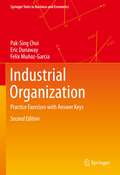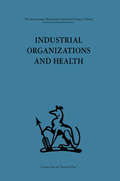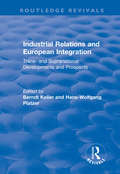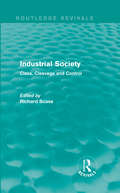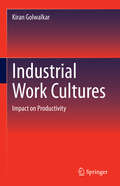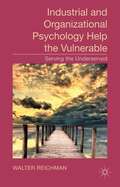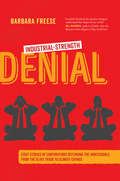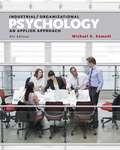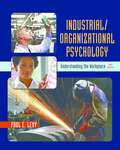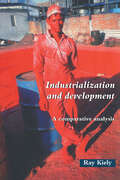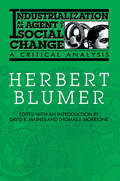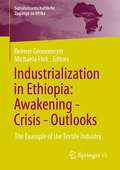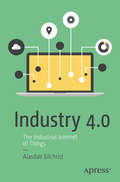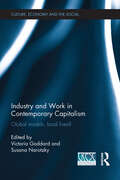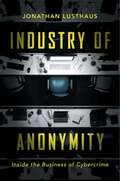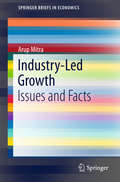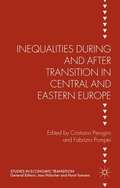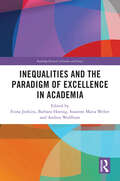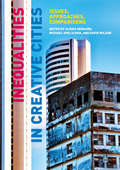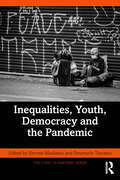- Table View
- List View
Industrial Organization: Practice Exercises with Answer Keys (Springer Texts in Business and Economics)
by Pak-Sing Choi Eric Dunaway Felix Muñoz-GarciaRevised and updated for the second edition, this textbook presents over 100 exercises on industrial organization with detailed answer keys. While most textbooks on industrial organization focus on theory and empirical findings, this textbook offers practical examples and exercises helping predict firm behavior in different industries. The book emphasizes the game-theoretic tools used in each type of exercise, so students can systematically apply them to other markets, forms of competition, or information environments where firms, consumers, and regulating agencies interact. The book begins with examples that analyze different models of firm behavior and interaction; starting with monopoly and moving through the Cournot model of simultaneous quantity competition, the Bertrand model simultaneous price competition, and sequential competition. The following chapters apply game-theoretic tools to situations of increasing complexity: regulation; R&D incentives; mergers and collusion; bundling incentives; incomplete information, signaling, and competition; networks and switching costs. In addition to providing algebraic simplifications, some chapters also offer the unique feature of worked exercises based on published journal articles by leading scholars in the field. Finally, exercises are ranked according to their difficulty, with a letter (A-C) next to the exercise number, which allows students to pace their studies and instructors to structure their classes accordingly. The second edition contains additional exercises optimized for study at the upper undergraduate level. Providing a rigorous, yet practical introduction to the field of industrial organization, this textbook is appropriate for advanced undergraduate and graduate students in economics and finance.
Industrial Organizations and Health
by Frank Baker Alan Sheldon Peter J. M. McEwanTavistock Press was established as a co-operative venture between the Tavistock Institute and Routledge & Kegan Paul (RKP) in the 1950s to produce a series of major contributions across the social sciences. This volume is part of a 2001 reissue of a selection of those important works which have since gone out of print, or are difficult to locate. Published by Routledge, 112 volumes in total are being brought together under the name The International Behavioural and Social Sciences Library: Classics from the Tavistock Press. Reproduced here in facsimile, this volume was originally published in 1969 and is available individually. The collection is also available in a number of themed mini-sets of between 5 and 13 volumes, or as a complete collection.
Industrial Relations and European Integration: Trans and Supranational Developments and Prospects (Routledge Revivals Ser.)
by Hans-wolfgang Platzer Berndt KellerThis title was first published in 2003.The completion of the Single Market and the launching of the European Monetary Union during the 1990s have been accompanied by processes of socio-economic restructuring and major changes in the structure and forms of governance within the dynamic multi-level EU system. The patterns of reaction and adaptation of national industrial relations systems to these EU - developments are discussed under the heading of "Europeanisation" of national IR-systems. The Maastricht and Amsterdam Treaties have extended - to a certain degree - the scope for legislative and coordinated activities by the EU in the fields of social, labour - market and employment policies. These basic legal and political decisions have created new avenues for the development of transnational industrial relations and the establishment of new arenas for EU - level interaction, including social dialogues between the social partners. .
Industrial Ruination, Community and Place
by Alice MahAbandoned factories, shipyards, warehouses, and refineries are features of many industrialized cities around the world. But despite their state of decline, these derelict sites remain vitally connected with the urban landscapes that surround them. In this enlightening new book, Alice Mah explores the experiences of urban decline and post-industrial change in three different community contexts: Niagara Falls, Canada/USA; Newcastle-upon-Tyne, UK; and Ivanovo, Russia.Employing a unique methodological approach that combines ethnographic, spatial, and documentary methods, Mah draws on international comparisons of the landscapes and legacies of industrial ruination over the past forty years. Through this, she foregrounds the complex challenges of living with prolonged uncertainty and deprivation amidst socioeconomic change. This rich comparative study makes an essential contribution to far-reaching debates about the decline of manufacturing, regeneration, and identity, and will have important implications for urban theory and policy.
Industrial Society: Class, Cleavage and Control (Routledge Revivals)
by Richard ScaseAny study of contemporary industrial societies must take into account the role of power, ideology and class, and the degree to which these determine the development of social structures. This book, first published in 1977 and based on a selection of eleven papers given at a conference of the British Sociological Association, focuses upon aspects of continuity and change in modern society, comparing and contrasting dimensions of class, cleavage and control in capitalist and socialist societies. This book is key reading for students of both sociology and business studies.
Industrial Sunset
by Steven HighPlant shutdowns in Canada and the United States from 1969 to 1984 led to an ongoing and ravaging industrial decline of the Great Lakes Region. Industrial Sunset offers a comparative regional analysis of the economic and cultural devastation caused by the shutdowns, and provides an insightful examination of how mill and factory workers on both sides of the border made sense of their own displacement. The history of deindustrialization rendered in cultural terms reveals the importance of community and national identifications in how North Americans responded to the problem.Based on the plant shutdown stories told by over 130 industrial workers, and drawing on extensive archival and published sources, and songs and poetry from the time period covered, Steve High explores the central issues in the history and contemporary politics of plant closings. In so doing, this study poses new questions about group identification and solidarity in the face of often dramatic industrial transformation.
Industrial Work Cultures: Impact on Productivity
by Kiran GolwalkarThis book addresses technical issues and human factors mainly from the mechanical, chemical, electrical, metallurgical and civil engineering fields as these make significant contribution to the economy and progress of a nation. It discusses factors that assist development of efficient, ideal work cultures and their influence on the productivity. It addresses undesirable traits in the working personnel which can cause deviations from good working practices. Suggestions are given for encouraging better performance and corrective actions for improvement of unsatisfactory working.
Industrial and Organizational Psychology Help the Vulnerable
by Walter ReichmanIndustrial and Organizational Psychology Help the Vulnerable documents a new direction for industrial and organizational psychology. The chapters are written by psychologists who have used the methods, procedures and theories of industrial and organizational psychology to help the vulnerable people of the world.
Industrial-Strength Denial: Eight Stories of Corporations Defending the Indefensible, from the Slave Trade to Climate Change
by Barbara FreeseCorporations faced with proof that they are hurting people or the planet have a long history of denying evidence, blaming victims, complaining of witch hunts, attacking their critics’ motives, and otherwise rationalizing their harmful activities. Denial campaigns have let corporations continue dangerous practices that cause widespread suffering, death, and environmental destruction. And, by undermining social trust in science and government, corporate denial has made it harder for our democracy to function. Barbara Freese, an environmental attorney, confronted corporate denial years ago when cross-examining coal industry witnesses who were disputing the science of climate change. She set out to discover how far from reality corporate denial had led society in the past and what damage it had done. Her resulting, deeply-researched book is an epic tour through eight campaigns of denial waged by industries defending the slave trade, radium consumption, unsafe cars, leaded gasoline, ozone-destroying chemicals, tobacco, the investment products that caused the financial crisis, and the fossil fuels destabilizing our climate. Some of the denials are appalling (slave ships are festive). Some are absurd (nicotine is not addictive). Some are dangerously comforting (natural systems prevent ozone depletion). Together they reveal much about the group dynamics of delusion and deception. Industrial-Strength Denial delves into the larger social dramas surrounding these denials, including how people outside the industries fought back using evidence and the tools of democracy. It also explores what it is about the corporation itself that reliably promotes such denial, drawing on psychological research into how cognition and morality are altered by tribalism, power, conflict, anonymity, social norms, market ideology, and of course, money. Industrial-Strength Denial warns that the corporate form gives people tremendous power to inadvertently cause harm while making it especially hard for them to recognize and feel responsible for that harm.
Industrial/Organizational Psychology: An Applied Approach
by Michael G. AamodtStriking a balance between research, theory, and application, the eighth edition of INDUSTRIAL/ORGANIZATIONAL PSYCHOLOGY: AN APPLIED APPROACH helps readers discover the relevance of industrial/organizational psychology in everyday life through practical application. Readers analyze topics such as resume writing, interview survival, job description authoring, performance appraisal, employment law, job satisfaction, work motivation, and leadership. Humor, case studies, real-world examples, and a friendly writing style make the book both readable and interesting. Numerous charts, tables, flowcharts, and exercises help readers conceptualize complex issues.
Industrial/Organizational Psychology: Understanding the Workplace
by Paul LevyWritten by a leading researcher in one of the nation's top I/O programs, Paul Levy's text has long been acclaimed for its concise, research-based approach, and personable writing style. The new edition again offers a thoroughly contemporary perspective on the field, with the latest research and new ways for students to explore what's happening in I/O psychology today.
Industrialization and Development: An Introduction
by Ray KielyAn introductory development studies text which puts industrialization into theoretical context, examines the forms it has taken, and considers economically efficient and socially responsible alternatives.
Industrialization as an Agent of Social Change: A Critical Analysis (Communication And Social Order Ser.)
by Herbert BlumerHerbert Blumer wrote continuously and voluminously, and consequently left a vast array of unpublished work at the time of his death in 1987. This posthumously published volume testifies further to his perceptive analysis of large-scale social organizations and elegant application of symbolic interactionist principles.Blumer's focus on the processual nature of social life and on the significance of the communicative interpretation of social contexts is manifest in his theory of industrialization and social change. His theory entails three major points: industrialization must be seen in processual terms, and the industrialization process is different for different historical periods; the consequences of industrialization are a function of the interpretive nature of human action and resembles a neutral framework within which groups interpret the meaning of industrial relations, and the industrial sector must be viewed in terms of power relations; industrial societies contain inherently conflicting interests.The editors' introductory essay outlines Blumer's metatheoretical stance (symbolic interactionism) and its emphasis on the adjustive character of social life. It places Blumer's theory in the context of contemporary macro theory, including world systems theory, resource dependence theory, and modernization theory.
Industrialization in Ethiopia: The Example of the Textile Industry (Sozialwissenschaftliche Zugänge zu Afrika)
by Reimer Gronemeyer Michaela FinkEthiopia, though remaining one of the least urbanised countries in the world, has taken impressive actions to transform the state into a more industrialized nation.Several industrial parks have been built in recent years throughout the whole country. The textile sector is one of these sectors. The textile industry is expected to provide employment for hundreds of thousands and thus improve people's living conditions and contribute to the development of the country. Major reason for asian investors to shift their focus to Ethiopia are extremely low wages and the lower production costs involved. The Ethiopian textile industry has to deal with high rates of labor turnover and absenteeism. From the perspective of the mostly international managers the reason for turnover and absenteeism is often attributed to the 'mindset' of the predominantly female workforce. A research project financed by the German Bundesministerium für wirtschaftliche Zusammenarbeit und Entwicklung is looking at reasons and possible measures to solve this problem. Results of this project (conducted at the University of Giessen by Michaela Fink and Reimer Gronemeyer together with Ethiopian colleagues are presented in this book. Experts from Ethiopia and Germany are presenting the history of the textile industry in Ethiopia and the coming development. All this is framed by the discussion of present crisis - Covid-19; the war - in Ethiopia).
Industry 4.0
by Alasdair GilchristExplore the current state of the production, processing, and manufacturing industries and discover what it will take to achieve re-industrialization of the former industrial powerhouses that can counterbalance the benefits of cheap labor providers dominating the industrial sector. This book explores the potential for the Internet of Things (IoT), Big Data, Cyber-Physical Systems (CPS), and Smart Factory technologies to replace the still largely mechanical, people-based systems of offshore locations. Industry 4. 0: The Industrial Internet of Things covers Industry 4. 0, a term that encapsulates trends and technologies that could rewrite the rules of manufacturing and production. What you'll learn What are the Industrial Internet and Industrial Internet of Things Which technologies must advance to enable Industry 4. 0 What is happening today to make that happen What are examples of the implementation of Industry 4. 0 How to apply some of these case studies What is the potential to take back the lead in manufacturing, and the potential fallout that could result Who this book is for Business futurists, business strategists, CEOs and CTOs, and anyone with an interest and an IT or business background; or anyone who may have a keen interest in how the future of IT, industry and production will develop over the next two decades.
Industry 4.0 Driven Manufacturing Technologies (Springer Series in Advanced Manufacturing)
by Yang Liu Ajay Kumar Parveen KumarThis book is a comprehensive guide to the latest advancements in manufacturing, adopting an Industry 4.0 approach. It covers the core principles of big data informatics, digital twin technology, artificial intelligence, and machine learning strategies. Readers will gain insights into the realm of cyber-physical intelligent systems in production, the role of blockchain, and the significance of information and communication technology. With a focus on real-time monitoring and data acquisition, the book offers practical solutions for online error troubleshooting in manufacturing systems. It explores a wide range of Industry 4.0-based applied manufacturing technologies and addresses the challenges posed by the dynamic market of production. Recognizing the lack of a cohesive resource on manufacturing advancements within the context of Industry 4.0, the authors have taken the initiative to compile this valuable knowledge from domain experts. Their goal is to disseminate these insights with this book. The book will be beneficial to various stakeholders, including industries, professionals, academics, research scholars, senior graduate students, and those in the field of human healthcare. With its comprehensive coverage, the book is an important reference for technical institution libraries and a useful reader for senior graduate students.
Industry 4.0: A Glocal Perspective (Routledge Studies in Management, Organizations and Society)
by Jerzy Duda Aleksandra GąsiorThe Fourth Industrial Revolution, also known as Industry 4.0, refers to the industrial paradigm bringing together the digital and physical worlds through the cyber-physical Systems, enhanced by the Internet of Things aimed to increase the effectiveness of human-machine cooperation (HMC). This book deals with issues related to the challenges of Industry 4.0 that are faced by enterprises and universities. Contrary to most publications on the subject, it covers both technological and business aspects of these challenges and shows how strong they are intertwined, bringing new value to readers. The book also presents new findings that will guide enterprises through Industry 4.0. This book offers readers an in-depth discussion of important areas of enterprises’ activities in the context of Industry 4.0. The first area concerns human resources management; in particular, what new employee competencies will be needed on the labor market, how to use modern concepts (e.g. design thinking), and how to manage multi-national teams of employees. The second area is related to marketing and covers issues regarding customized products. The third area is devoted to technical aspects such as autonomous vehicles, Internet of Things (IoT), radio-frequency identification (RFID) systems, and Bluetooth Low Energy (BLE) technology. The fourth area concerns IT systems, including systems that support work and business management, strategic information systems, and cyber-physical systems. Aimed at researchers, academics, practitioners, and students, it will be of value to those in the fields of human resource management, marketing, organizational studies, and management of technology and innovation.
Industry and Work in Contemporary Capitalism: Global Models, Local Lives? (CRESC)
by Susana Narotzky Victoria GoddardThroughout history and in every geographical location, the rise and fall of industry, which impact the fate of large populations, are tied to the development and cultural entanglement of particular models that are articulated with political power. Models are understood as knowledge devices – expert, theoretical, practical and commonsense – that are embedded in cultural and social environments and designed through struggles at various scales. This book results from the collaboration of an interdisciplinary team bringing together specialists in anthropology, geography, sociology, economics, political science, mathematics and engineering around the theme of ‘Models and their Effects on Development Paths’. Based on empirical research conducted on the heavy industries, Industry and Work in Contemporary Capitalism addresses how models that inform the organization of work and production and are created by powerful actors may diverge from, overlap with, or contradict the models articulated by less powerful actors on the ground, and how they are connected across material and cultural spaces. Careful observation of industrial work and production as they unfold in and across specific localities and affects people’s livelihoods is complemented by analysis of how models circulate, through which channels of power, which institutional entities, which political connections. This volume explores an extensive theoretical terrain and a number of empirical cases that show, from different perspectives, how ideas about the economy, about work and industry, materialize in specific practices and interventions that affect people’s livelihoods.
Industry of Anonymity: Inside the Business of Cybercrime
by Jonathan LusthausJonathan Lusthaus lifts the veil on cybercriminals in the most extensive account yet of the lives they lead and the vast international industry they have created. Having traveled to hotspots around the world to meet with hundreds of law enforcement agents, security gurus, hackers, and criminals, he charts how this industry based on anonymity works.
Industry-Led Growth
by Arup MitraThe book explores, for India and other developing countries, the potential role the organized manufacturing sector could play as an engine of growth. Alongside growth, can this sector generate adequate employment opportunities to facilitate the transfer of labour from the agriculture sector? The book identifies the major constraints that result in limited demand for labour in the organised manufacturing sector. Beyond technological aspects, skill shortage is an important factor, resulting in sluggish labour absorption. Further, the labour market laws are not necessarily the root cause of sluggish employment growth in the organised manufacturing sector. The development of technologies that are appropriate for labour surplus countries like India is instrumental to employment creation. Though innovation is generally assumed to be capital-intensive in nature, the book argues that innovation nevertheless has a positive effect on employment in absolute terms. Lastly, the main policy issues are highlighted in terms of the priority that should be assigned to industries which can contribute to employment growth and skill formation for improving the employability of the available labour force, and to which innovations should bepursued, with a specific focus on pro-poor growth objectives.
Inequalities During and After Transition in Central and Eastern Europe
by Cristiano Perugini Fabrizio PompeiThe book deals with the key aspects of social and economic inequalities developed during the transition of the formerly planned European economies. Particular emphasis is given to the latest years available in order to consider the effects of the global crisis started in 2008-2009.
Inequalities and the Paradigm of Excellence in Academia (Routledge Research in Gender and Society)
by Fiona Jenkins, Barbara Hoenig, Susanne Maria Weber and Andrea WolfframThis volume examines the criteria of excellence producing inequalities of gender in the daily working environment and evaluation of academics. Policymakers have increasingly placed emphasis on gender equality as part of a strategy for achieving research excellence, and efforts to reduce gender bias have become mainstream. This book suggests that this goal has remained elusive in practice due to continuing under-representation of women across many academic and scientific fields. Questioning the old structures of male dominance still prevalent in national research policy, the book explores the effects of institutional values and practices on the careers of academics, particularly the academic identities of women and their career developments. It focuses on case studies drawn from Europe while also highlighting the rise of new forms of public management and a neoliberal framing of the value of academic work, that have a much broader global reach. Using participatory research, the book analyses contemporary forms of "gendered excellence" in an intersectional and international perspective. It will be of interest to junior/senior researchers, teachers, and scholars in sociology, education, gender studies, history, political science and science and technology studies.
Inequalities in Creative Cities
by David Wilson Michael Hoelscher Ulrike GerhardThis edited volume is a lively and timely appraisal of "ordinary cities" as they struggle to implement creative redevelopment and economic growth strategies to enhance their global competitiveness. The book is concerned with new and often unanticipated inequalities that have emerged from this new city movement. As chronicled, such cities - Cleveland (USA), Heidelberg (Germany), Oxford (UK), Groningen (Netherlands), Montpellier (France), but also cities from the Global South such as Cachoeira (Brazil) and Delhi (India) - now experience new and unexpected realities of poverty, segregation, neglect of the poor, racial and ethnic strife. To date planners, academics, and policy analysts have paid little attention to the connections between this drive in these cities to be more creative and the inequalities that have followed. This book, keenly making these connections, highlights the limited visions that have been applied in this planning drive to make these cities more creative and ultimately more globally competitive.
Inequalities, Youth, Democracy and the Pandemic (The COVID-19 Pandemic Series)
by Simone MaddanuThis book brings together studies from various locations to examine the growing social problems that have been brought to the fore by the COVID-19 outbreak. Employing both qualitative, theoretical and quantitative methods, it presents the impact of the pandemic in different settings, shedding light on political and cultural realities around the world. With attention to inequalities rooted in race and ethnicity, economic conditions, gender, disability, and age, it considers different forms of marginalization and examines the ongoing disjunctions that increasingly characterize contemporary democracies from a multilevel perspective.The book addresses original analyses and approaches from a global perspective on the COVID-19 pandemic, its governance, and its effects in different geographies. These analyses are organized around three main axes: 1) how COVID-19 pandemic worsened social, racial/ethnic, and economic inequalities, including variables such as migration status, gender, and disability; 2) how the pandemic impacted youth and how younger generations cope with public health alarms, and containment measures; 3) how the pandemic posed a challenge to democracy, reshaped the political agenda, and the debate in the public sphere. Contributions from around the world show how local and national issues may overlap on a global scale, laying the foundation for connected sociologies. Based on qualitative as well as quantitative empirical analysis on various categories of individuals and groups, this edited volume reflects on the sociological aspects of current planetary crises which will continue to be at the core of our societies.A wide-ranging, international volume that focuses on both unexpected social changes and new forms of agency in response to a period of crisis, Inequalities, Youth, Democracy and the Pandemic will appeal to scholars with interests in the sociology of health, social problems and inequalities.
Inequality And Stratification: Race, Class and Gender
by Christopher B. Doob Robert A. Rothman<P>Using a concise and easy-to-understand style, this guide provides an integrated approach to the implications of social class, race and ethnicity, and gender—explaining how each relates to economic, social, and political inequality. Its straightforward perspective views the considerations of race and gender as central to a full appreciation of the composition and dynamics of class systems. A significant and effective organization incorporates fresh conceptualizations, new research findings, and census data, with the fundamentals of social stratification. <P>Five-part organization:Part I gives a broad overview and introduction to the field; Part II provides an expanded discussion of the evolution and institutionalization of industrial class systems;Part III covers the basic elements of inequality: economics, prestige, and politics;Part Four includes separate chapters on life chances and lifestyles as well as class consciousness; and Part V offers an exploration of social mobility. As a useful reference for professionals in the fields of sociology, social problems, or race and minorities/gender.
